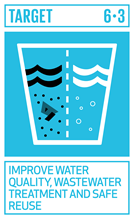
The UN-Water Integrated Monitoring Initiative for SDG 6
The UN-Water Integrated Monitoring Initiative for SDG 6 supports countries in monitoring water- and sanitation-related issues within the framework of the 2030 Agenda for Sustainable Development, and in compiling country data to report on global progress towards Sustainable Development Goal (SDG) 6. The 2020 Data Drive is part this Integrated Monitoring Initiative for Sustainable Development Goal 6 (IMI-SDG6) and involves countries collecting and reporting data on various SDG 6 indicators to multiple UN agencies. The United Nation Environment Programme is supporting countries to report on SDG indicator 6.3.2.
SDG Indicator 6.3.2: "Proportion of bodies of water with good ambient water quality"
Target 6.3 sets out to improve ambient water quality – this page explains why and how to monitor progress towards the indicator 6.3.2 under this target, and what support is available for countries to do so.
Indicator 6.3.2 “Proportion of bodies of water with good ambient water quality” tracks the percentage of water bodies in a country with good ambient water quality. "Good ambient water quality" is water of a certain standard that flows in our rivers, lakes and aquifers without causing harm to human or ecosystem health. This explanation sounds straightforward but, in practice, it is complicated to define good ambient water quality.
The methodology recognises that countries have different levels of capacity to monitor and assess water quality, with many developed countries operating extensive programmes that collect and report data to existing reporting frameworks. At the other end of the scale, several of the least developed countries currently do not monitor ambient water quality or operate very limited programmes. In the spirit of the SDGs, the methodology is designed to be as flexible and straightforward as possible and aims to ensure that no one is left behind.
This is achieved by prescribing the measurement of standardised basic core components (Level 1), whilst providing sufficient flexibility to adapt the methodology to meet national and local conditions (Level 2). Level 1 monitoring maintains the global comparability of the indicator by using simple to measure characteristics of water that represent pressures that are relevant everywhere. The impacts from these pressures include nutrient enrichment; oxygen depletion; salinization and acidification. The parameters used to measure these impacts can be analysed in the field and do not require laboratory facilities. Level 1 is limited in scope and, although it provides good information, it cannot represent all pressures to freshwater quality. Level 2 goes further and provides the flexibility for countries to include information that may be of national concern or relevance. Level 2 reporting may use additional sources of data, such as analyses of other parameters, e.g. heavy metals, or approaches other than the basic physical and chemical methods used in Level 1. These approaches may include biological or microbiological methods, satellite-based Earth observation techniques, or citizen scientist initiatives.

The methodology calls for in-situ measurements of these water quality parameters. The measured values are compared to national target levels for the different parameters, and if values do not exceed the target level, the water body is classified as good.

Available support:
Documents and materials to help you report on SDG indicator 6.3.2 can be found here.
Contact our SDG 6.3.2 helpdesk under sdg632@un.org
